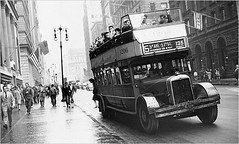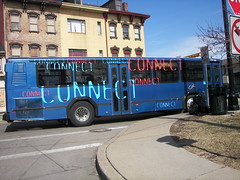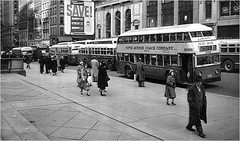Making bus service sexy
In my "The revised revised People's Transportation Plan/2008 Transit-Transportation wish list," (last revised in late February) point 20 is:
Improve the bus service. I say do this before thinking about streetcars. We need to make bus service exciting and sexy, in order to boost transit use. I recommend better marketing and wayfinding systems, better bus shelters (coming) and waiting stations, and probably sexier buses, which to my way of thinking, would be double deckers, on routes that could accommodate them. Double deckers are 40 feet long, and more maneuverable than 60 foot articulated buses.
-----
NYC Transit is considering bringing double-decker buses back to 5th Avenue in Manhattan, to serve leisure and commuter trips. See "Step to the Rear of the Bus, Please, or Take a Seat Upstairs," from the New York Times.

Photo: Metropolitan Transportation Authority. A double-decker bus on Fifth Avenue in 1946. Similar vehicles are now used for sightseeing.
According to the article:
Howard H. Roberts Jr., the president of New York City Transit, said on Thursday that he is considering bringing the two-level buses back to Fifth Avenue. Mr. Roberts said his interest was based on simple economics. Double-deckers can carry about as many people as the longer bus that the transit agency now uses, according to Joseph Smith, senior vice president for the agency’s bus operations. But they cost less to maintain because they lack the complicated connector and accordion apparatus that links the two portions of an articulated bus.
Plus they don't take as much space. OTOH, they can't get into certain places, like bus terminals (Friendship Heights, Bethesda) with low ceilings. And I don't know if there are issues on hills.
The Downtown Circulator is a major re-articulation of how bus service can look in DC. Especially in design (and I think that the "dress" or graphic design of the Circulator is far better than other branded Metrobus service like MetroRapid and the Rex Express--I find those painting schemes to still be pretty dowdy).


It aggravates regular Metrobus riders though, because we think that the reason the Circulator looks attractive and has more comfortable seats and a cheaper price is because they are focusing on people who have the means to choose whether or not they ride the bus.
It's true. It is. But so what. The more riders, and the more people supporting transit, the better. (As long as there is money to add equipment and service.)
But it also shows the value of marketing.
"Sex up" or "tart up" bus service by completely changing how it is viewed with vehicles, bus stop signage, and bus shelters.
------
Note that the Las Vegas NV and Victoria, BC transit systems use double decker buses extensively, and Community Transit in Snohomish County, WA has started. The SF MUNI system has tested them.
Note also that the Boulder transit system is known for naming their bus routes rather than using a combination of letters and/or numbers, and paiting the buses specifically for their route. And many of Pittsburgh's buses are used as rolling transit marketing vehicles, including pro-transit advertising messages or words promoting the link between mobility and public transit.

Get connected from here to there by a Port Authority of Allegheny County bus.

The New York Times. Two-level buses ran regularly in Manhattan from early in the 20th century until 1953, and made a brief return in the ’70s.
Labels: transit, transit marketing



0 Comments:
Post a Comment
<< Home